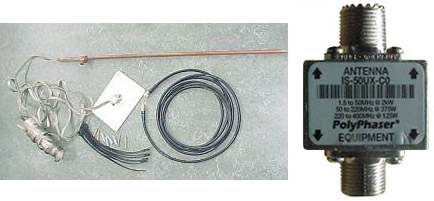MODULE, LIGHTNING ARRESTOR, for antenna
Valid Article
MODULE, LIGHTNING ARRESTOR, for antenna
Definition
Complete lightning protection device for fixed HF/VHF/UHF radio installations.
Indications
The lightning protection device includes:
- 1 lightning protection box
- 1 earthing braid
- 1 earthing rod
- cabling and installation set
Lightning protection box ("fuse box")
- Metal box containing a fuse
- 2 UHF PL female/female connectors
- Mounted on a teflon plate allowing wall fixing
Earthing braid
- 10 mm²
- Non modifiable length, 10 metre
Earthing rod
- Made of copper only, no galvanised iron
- Non modifiable length: 1.50 metre
Instructions for use
This lightning protection device MUST be installed for all radio equipment (one device per HF, VHF, and UHF radio).
If a radio room is equipped with one HF radio and one VHF radio, two lightning protection devices should be installed and connected separately to earth (never by means of one single earthing rod because of the risk of an earth loop and inter-radio interference).
Installation
The lightning protection box MUST be fixed OUTSIDE the radio room, as close as possible to the antenna, bearing in mind the length of the coaxial cable linking the radio and the lightning protection box (10 metre).
The earthing rod MUST be fully driven into the ground. The best way to proceed is to dig to a depth of 1.5 metre and to bury the rod. Putting charcoal into the hole along with earth will increase electrical conductivity.
Functioning
When lightning strikes the antenna mast, a strong electric current passes through it. This current will take the shortest and most conductive path to earth. As the current passes through the "fuse" box, the fuse cuts out and opens a path to the earthing strap (good conductor) and the earthing rod (excellent conductor) buried in the ground. The radio and other equipment connected to the coaxial cable are therefore protected.
If your antenna mast has been struck by lightning, the "fuse" box must always be replaced. Cables and connections must also be checked and any burned or damaged item replaced as soon as possible.
An unusally high Standing Wave Ratio, as read from the SWR meter (over 3) indicates a strong likelihood that the lightning protection box has been damaged by lightning.
Precautions for Use
It is very important not to replace the copper rod and the braided earthing strap with other materials as this would reduce the conductivity and make the protection ineffective.
MSF requirements
Indispensable for each radio installation to protect both staff and radio equipment.


![[PCOMCOAXA10PM] COAXIAL CABLE Aircell 7, 10m, UHF-PLx2, MxM](/web/image/product.template/547597/image_256/%5BPCOMCOAXA10PM%5D%20COAXIAL%20CABLE%20Aircell%207%2C%2010m%2C%20UHF-PLx2%2C%20MxM?unique=af4eb5d)
![[PCOMCONNCPPFU] ADAPTER coaxial, PL to PL, FxF](/web/image/product.template/546512/image_256/%5BPCOMCONNCPPFU%5D%20ADAPTER%20coaxial%2C%20PL%20to%20PL%2C%20FxF?unique=5246fd6)
![[PCOMPROTLAB] (antenna lightening arrestor) BOLTS + NUTS, set](/web/image/product.template/547628/image_256/%5BPCOMPROTLAB%5D%20%28antenna%20lightening%20arrestor%29%20BOLTS%20%2B%20NUTS%2C%20set?unique=2df72dc)
![[PCOMPROTLAF] (antenna lightening arrestor) FUSE BOX](/web/image/product.template/546477/image_256/%5BPCOMPROTLAF%5D%20%28antenna%20lightening%20arrestor%29%20FUSE%20BOX?unique=ea8d40a)
![[PCOMPROTLAP] (antenna lightening arrestor) FIXING PLATE](/web/image/product.template/547627/image_256/%5BPCOMPROTLAP%5D%20%28antenna%20lightening%20arrestor%29%20FIXING%20PLATE?unique=2df72dc)
![[PCOMTAPEV10] SELF-VULCANISING TAPE, 10m, roll](/web/image/product.template/548798/image_256/%5BPCOMTAPEV10%5D%20SELF-VULCANISING%20TAPE%2C%2010m%2C%20roll?unique=fb150f8)
![[PELEEARTBPMT] EARTH BRAID, copper, 10mm², per metre](/web/image/product.template/549704/image_256/%5BPELEEARTBPMT%5D%20EARTH%20BRAID%2C%20copper%2C%2010mm%C2%B2%2C%20per%20metre?unique=4079040)
![[PELEEARTR15] GROUNDING ROD, copper, 1.5m](/web/image/product.template/549707/image_256/%5BPELEEARTR15%5D%20GROUNDING%20ROD%2C%20copper%2C%201.5m?unique=4079040)
![[KCOMKVHF13-] KIT VHF, TRANSCE., 5 handsets (ICF3262DT) + base (ICF5061DP)](/web/image/product.template/567340/image_256/%5BKCOMKVHF13-%5D%20KIT%20VHF%2C%20TRANSCE.%2C%205%20handsets%20%28ICF3262DT%29%20%2B%20base%20%28ICF5061DP%29?unique=9b9df8a)
![[KCOMKVHFM50] KIT VHF, TRANSCEIVER, mobile (Icom ICF5061)](/web/image/product.template/548215/image_256/%5BKCOMKVHFM50%5D%20KIT%20VHF%2C%20TRANSCEIVER%2C%20mobile%20%28Icom%20ICF5061%29?unique=ffe1076)
![[KCOMMHFBDIP] MODULE, HF, ANTENNA, BASE, dipole](/web/image/product.template/548142/image_256/%5BKCOMMHFBDIP%5D%20MODULE%2C%20HF%2C%20ANTENNA%2C%20BASE%2C%20dipole?unique=6220791)
![[KCOMMHFBD2T] MODULE, HF, ANTENNA, BASE, D2T](/web/image/product.template/548141/image_256/%5BKCOMMHFBD2T%5D%20MODULE%2C%20HF%2C%20ANTENNA%2C%20BASE%2C%20D2T?unique=6220791)
![[KCOMMHFBLOP] MODULE, HF, ANTENNA, BASE, tuned loop](/web/image/product.template/548140/image_256/%5BKCOMMHFBLOP%5D%20MODULE%2C%20HF%2C%20ANTENNA%2C%20BASE%2C%20tuned%20loop?unique=6220791)